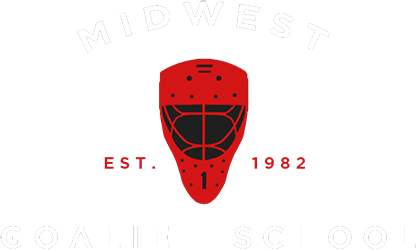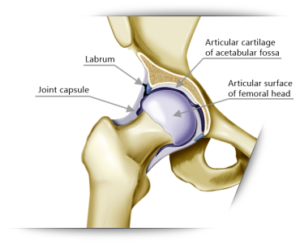
Credit: Carona Station PT
There is no other sport as hard on the hips as being a goalie. During my career as a Doctor of Physical Therapy, and discussing with Eric about his experiences as a professional, I find that many goalies suffer from hip impingement or labral injuries. It is important to be proactive with maintaining the integrity of the hip joint and the surrounding muscles through lower body stretching, strengthening the glutes and core, and doing self joint mobilizations at the gym or home.
The hip joint is a ball and socket joint with three degrees of rotation. It is best described as being a functionally mobile joint as it has the ability to rotate in three planes of motion. The muscles work to disperse forces on the bones or joints as suspension wires work to reduce load on bridge structures. The major muscle groups responsible for alleviating force on the hips include the gluteal and abdominal musculature. It is pivotal that goalies keep their hips strong and flexible and mobile.
I’m guessing as an athlete you’ve worked out before, and particularly if you’re a goalie, basic stretching is part of your routine. Doing general hip stretches and strengthening is not a bad start; it is better than doing nothing. Maybe it is the physical therapist in me that says, “There has to be certain exercises that are more functional and specific to goalies. If so, what are they?” Let’s go a little deeper in the mechanics of the three most common positions goalie’s must be proficient in- Athletic Stance, Butterfly, and the RVH (Reverse Vertical-Horizontal).
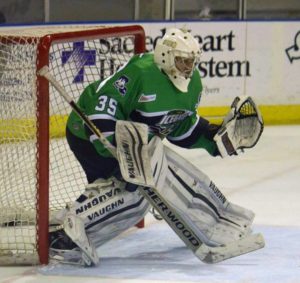
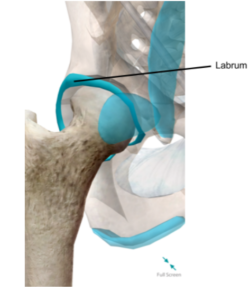 Typically, goalies get into a stance that is low and athletic by bending their knees and squatting down while their knees align inward with their skates positioned to move either direction. Maintaining this is called valgus position, which causes the space between the hip labrum and ball and socket to physically be reduced. After many repetitions, it is possible for the labrum to begin to shear and tear. The other problem with maintaining the knee valgus position is that it can cause compression and shearing on the lateral meniscus at the knee by pulling on the medial collateral ligament (MCL).
Typically, goalies get into a stance that is low and athletic by bending their knees and squatting down while their knees align inward with their skates positioned to move either direction. Maintaining this is called valgus position, which causes the space between the hip labrum and ball and socket to physically be reduced. After many repetitions, it is possible for the labrum to begin to shear and tear. The other problem with maintaining the knee valgus position is that it can cause compression and shearing on the lateral meniscus at the knee by pulling on the medial collateral ligament (MCL).
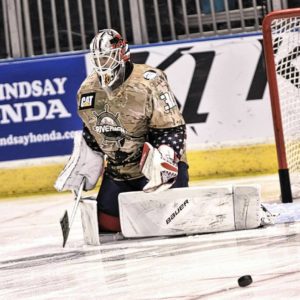 Dropping to your knees and flaring the feet outward in the butterfly causes stress to the hip joint. The mechanics that is occurring at the ball & socket is internal rotation of the hip and distraction (decompression). Internal rotation occurs, but being connected to the ice by gravity can generate more compression rather than distraction. In addition, your upper body tilting forward to get into a “blocking butterfly” or even lunging forward to cover the puck can cause the pelvis to go into an anterior pelvic tilt (forward tilting) that can further minimize space or compress the hip socket. Training your body to play while engaging your abdominal muscles can be a great start towards avoiding this position.
Dropping to your knees and flaring the feet outward in the butterfly causes stress to the hip joint. The mechanics that is occurring at the ball & socket is internal rotation of the hip and distraction (decompression). Internal rotation occurs, but being connected to the ice by gravity can generate more compression rather than distraction. In addition, your upper body tilting forward to get into a “blocking butterfly” or even lunging forward to cover the puck can cause the pelvis to go into an anterior pelvic tilt (forward tilting) that can further minimize space or compress the hip socket. Training your body to play while engaging your abdominal muscles can be a great start towards avoiding this position.

In the RVH position-with the skate anchored into the post while leaning the upper body past the hip joint towards the foot-the hip is placed in a vulnerable position. Similar to the butterfly, internal rotation and compression is occuring at the hip, and the pelvis is going into an anterior pelvic tilt; except there is significantly more weight being placed on the side against the post. This stress on the hip joint can be combated by engaging the abdominal muscles and utilizing your glutes to balance the compression and internal rotation
It is crucial that exercises for goalies to be designed to maintain joint space and mobility to prevent continuous rubbing/shearing on the labrum. Goalies need to be ready to be explosive and quick to react at any time. Much of that comes from having a strong lower body. Maintaining good abdominal, quadricep, and glute strength/stamina will be important for keeping the knees and hips healthy. The glutes work as external rotators to combat the internal rotation during stance, butterfly, and RVH position. Strong abdominals aid in maintaining joint space. In terms of what exercises you can do, I would start by getting your hip joints loosened, and then make sure your muscles feel flexible. Many times, you will have a hard time recruiting your abs and glutes if your lower body is tight
The order can be as follows
1) Roll out (quads, hamstrings, groin, and glutes) with a foam roller, softball or Lax ball. https://www.youtube.com/watch?v=94pudiiGNCU – 45-60 seconds each side x 2 repetitions to either side that is most sore.
2) Trigger Point Release: 8-10 reps straight on the quad muscle just above the knee, then switch to the outside near the IT band and perform 8-10 reps. https://outu.be/s-bomTi85Y4
3) Perform a dynamic Inchworm stretch for 2 lengths at 25 feet each. https://www.youtube.com/watch?v=Z19gpqxQBwo
4) Hip 90/90 stretch. Stretch chest to knee for 15-30 seconds, then stretch chest to midpoint of lower leg for 15-30 seconds. Perform 3x each position, then switch sides https://www.youtube.com/watch?v=Or5MINtRCk8
5) Finish by doing Hip Flexor stretch. Perform 30 second holds x 3 repetitions. https://www.youtube.com/watch?v=vwToKziL5A4
Hip Strengthening Progression
- Gluteal Isometrics
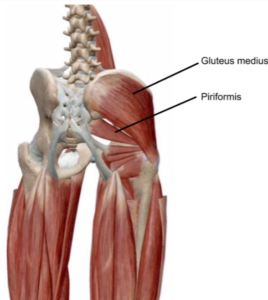
- Position: Lying on your back with knees bent
- While lying on your back, try to squeeze one of your glute medius muscles at time (this is needed with every repetition) and hold it for 2-3 seconds. See if you can alternate and do this on the other side.
- Do this 5-10x each hip
- Double leg bridges
-
-
- Position: Lying on your back with knees bent
- Next, contract both glute muscles and lift your hips off the ground/floor surface. Hold for 2-3 seconds at the top. Be sure not to arch your back.
- This should be felt in both glutes at the top of the hold.
- Perform 2 sets of 10 repetitions.
-
- Single leg bridges
-
-
- Position: Lying on your back with knees bent
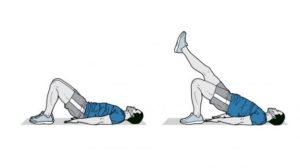 Lift one leg up, and it should be parallel with your opposite thigh.
Lift one leg up, and it should be parallel with your opposite thigh. - Contract the glute on the side of the foot touching the ground.
- Lift the both hips off the ground with one leg in the air.
- You should feel the glute contract to bring you hips off the ground. Be sure not to feel pressure in your back.
- Hold for 2-3 seconds at the top.
- Perform 2-3 sets of 5-7 repetitions.
-
- Horizontal Figure 4 Bridge
-
-
- Position: Lying on your back with knees bent
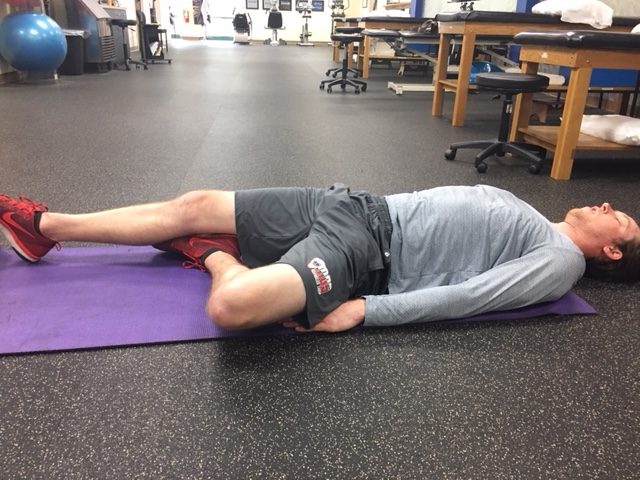
- Drop one knee off to the side, and your legs should resemble a figure 4.
- The heel of the figure 4 should be underneath the back of the knee joint on the other leg. (ankle should contact ground)
- Contract the glute on the side of the leg that is under the knee joint.
- Push the outside of the underside ankle, and heel of the top of the leg into the ground.
- Lift the both hips off the ground.
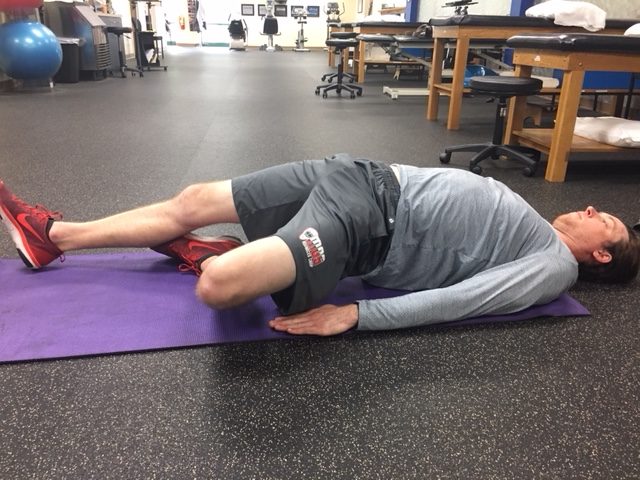 You should feel the glute contract to bring you hips off the ground. Be sure not to arch or feel it in your back.
You should feel the glute contract to bring you hips off the ground. Be sure not to arch or feel it in your back.- Hold for 2-3 seconds at the top.
- Perform 2-3 sets of 5-7 repetitions.
- Position: Lying on your back with knees bent
-
- Sidelying clamshells
-
-
- Lie on your side with your knees bent.
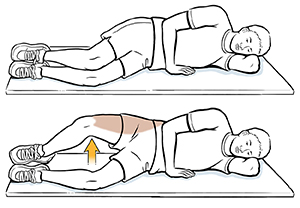
- Hips should be stacked on top of each other.
- Squeeze the top glute, and lift up the top knee without allowing your hip to fan backwards.
- The hips should stay forward, and the contraction should be felt throughout the glutes, not the top thigh.
- Perform 2-3 sets of 7-12 repetitions.
- Lie on your side with your knees bent.
-

Education
